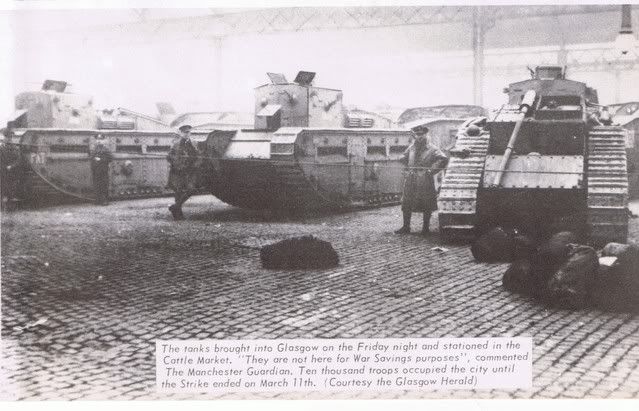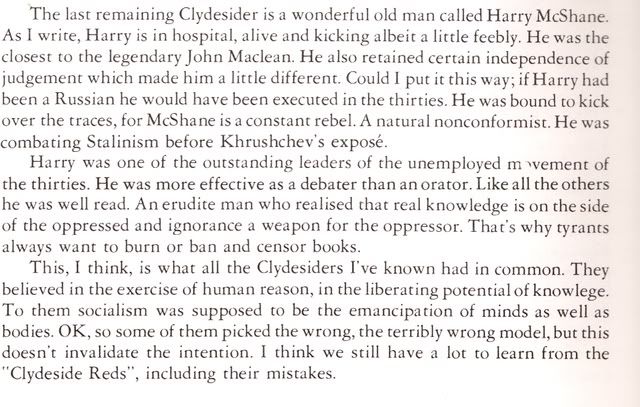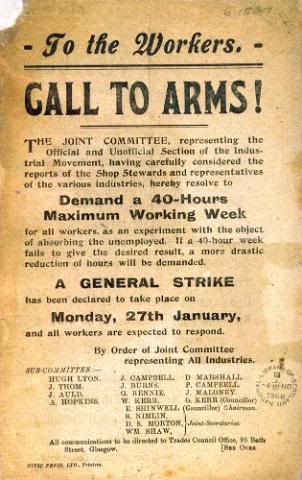
40,000 Glasgow workers came out on strike on Monday 27 January & 70,000 on the following day. Traffic control also came under the jurisdiction of the strike movement. For example, there was the issue of special permits to drivers conveying school fuel. But the greatest challenge came in the attempts of the strikers to stop the trams from running. On the Friday before the strike, the Joint committee, the leading body of the strike movement, had instructed the magistrates that the trams must be off the roads for the duration of the strike. When the magistrates failed to comply, the strikers took the matter into their own hands: all over the city strikers cut the ropes connecting the trollies to the overhead lines, with the result that hundreds of trams blocked the routes and dislocated the whole tram service. Police were physically driven off if ,they attempted to prevent the trams from being immobilised. During one incident in the Saltmarket when two constables tried to stop a tram from being immobilised the strikers pulled the clothes off the two men and they had to run for their lives naked.
The strike continued through the week cumulating with a mass meeting in George Square on Friday 31 January to hear Lord Provost Sir James Watson Stewart read a response from the Government to the unions' request for Government intervention in the dispute.
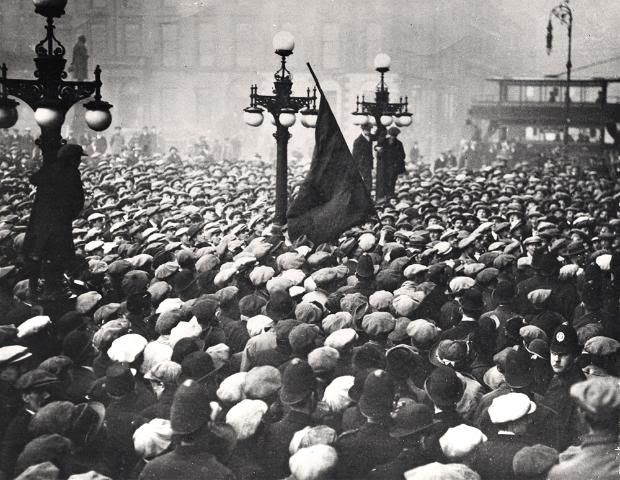
Emanuel Shinwell, the Independent labour Party activist and chairman of the Glasgow Trades Council, and fellow-ILPer Hopkins, an engineering union leader, were among those to address the crowd.
Shinwell (left) & Hopkins address the crowd from the front of the City Chambers
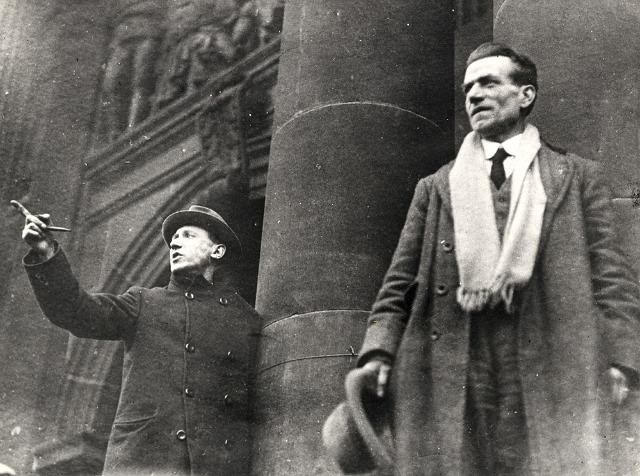
The riot which ensued on 'Bloody Friday' between the police and protesters is widely believed to have been started by a police baton charge against what was, up until that point, a peaceful demonstration.
Some sources indicate that trams running through the strike may have started the riot. City magistrates had been forewarned of the dangers of keeping trams on the streets at a time when 10,000 strikers were marching from the halls to occupy George Square. But the warning was ignored, and the riot started after a tram tried to make its way through the square while strike leaders were inside the City Chambers awaiting talks with the Provost.
The peaceful protest having been provoked changed the scene and the mood almost immediately, the police now confronted an angry crowd of workers who met baton charges with fists and bottles. Sheriff MacKenzie's attempts to read the Riot Act during the 'Battle of George Square' proved unsuccessful as the crowd tore the Act from him as was in the process of reading it:
Sherrif MacKenzie (5th from left) and other leading Glasgow law officers look on immediately after the attempted reading of the Riot Act in George Square.
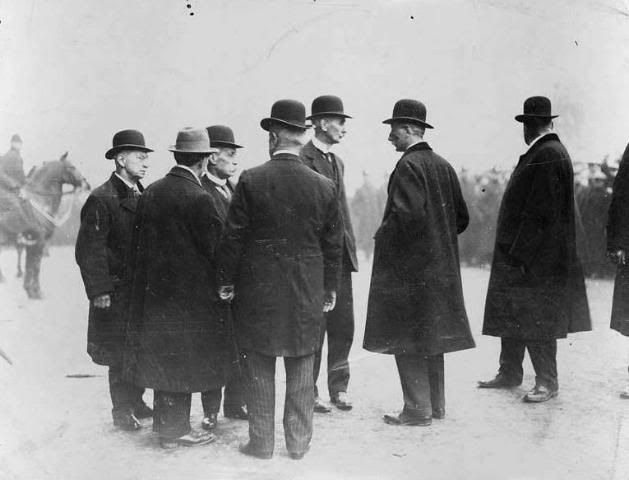
The reading of the Riot Act was the traditional method used by police authorities to disperse crowds of protesters. Any persons left loitering with intent after the reading of the Act was liable for arrest.
The fierce rioting between police and protesters began whilst a CWC deputation was in the City Chambers meeting with the Lord Provost of Glasgow. On hearing the ensuing riot that was taking place in George Square between the police and protesters, CWC leaders Davie Kirkwood and Emmanuel Shinwell moved outside to attempt to quell the riot. Before they could reach the crowds outside Kirkwood was beaten to the ground by police and both himself and Shinwell arrested.
Davie Kirkwood lies on the ground after being struck by a truncheon:

Gallagher & Kirkwood are arrested:
 .
. Pitched battles took place between police and strikers in the streets around the square. Iron palings were pulled up and used as a defence against the police truncheons, while bottles were mobilised from a passing lorry to serve as missiles. The Police had anticipated that their baton charge would drive the crowd out of the square - not so. Not only did the strikers and their supporters stand their ground but drove the police back. Eventually there was a re-grouping and the workers began to move off from George Square to march towards Glasgow Green.
Glasgow’s leading law Officers survey the scene in George Square in the aftermath of the riot:
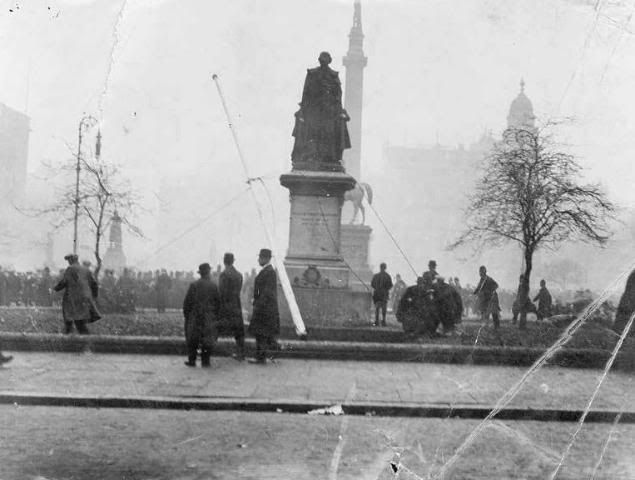
At the front of this march were ex-servicemen who had returned from the war to "a home fit for heroes" and who were completely in support of the strike. When they reached the Green the police were waiting, ready to charge again. Undaunted the strikers, led by the ex-servicemen, pulled up the park railings and chased off their attackers. For the rest of the day and into the night, further fighting took place throughout the city.
But the defeat of the police put an end to the government's hesitation. Thousands of troops, fully equipped, poured into Glasgow late on the night of Bloody Friday and early Saturday morning. "Accompanied by heavy munitions wagons, the general appearance of long columns of khaki-clad men... suggests that at last the government is in earnest in the measures to crush the new revolutionary spirit," wrote the Glasgow Evening News.
Scottish soldiers billeted at Maryhill barracks were not used. They were all veterans of the front and could not be trusted to obey orders to turn their guns on the strikers. Instead, the government used young and inexperienced English troops, who were ignorant of the situation.
Howitzers were positioned in the City Chambers, the cattle market was transformed into a tank depot, machine guns were posted on the top of hotels and, remembering Easter 1916, the main post office, and armed troops stood sentry outside power stations and patrolled the streets:
Photograph showing armed English soldiers on sentry duty at Glasgow's Princes Docks in the days following the Battle of George Square. The English troops deployed in Glasgow were mainly young conscripts aged between 17 and 19, as can be clearly seen from the photograph:
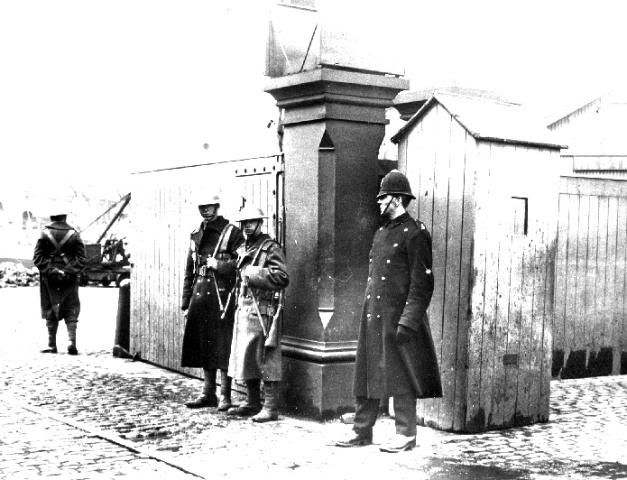
The soldiers pictured here are sleeping beneath what appears to be a cartoon prepared for stained glass windows, representing the supposed defence of the Cathedral by members of the Trades' House in 1579. The location is unknown.
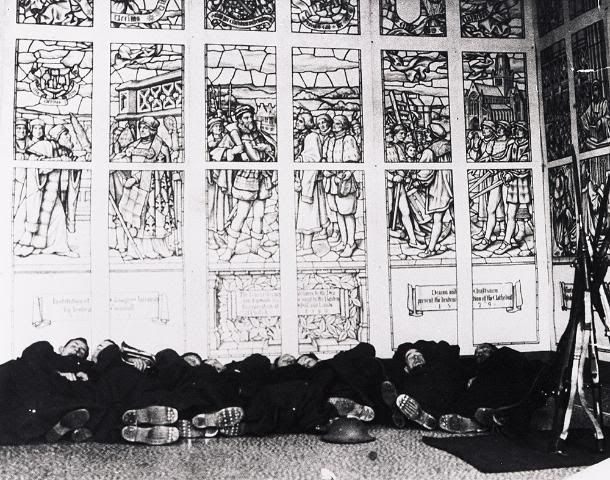
New regulations were also introduced by the government to legalise whatever violence the troops might need to use to break the strike. If the troops were used to suppress any fighting involving the strikers the Riot Act must first be read - but only "if circumstances permit". Similarly, the commanding officer had to consult with the magistrates before opening fire - but again only "if time permits".
Most revealing of all was regulation 965: "It is undesirable that firing should take place over the heads of rioters or that blank cartridges should be used."
Single page leaflet, published by Joint Strike Committee of the 40 Hours Movement in the immediate aftermath of the battle of George Square.
The aim of this leaflet was to inform the wider British Labour Movement of the events which had taken place on 'Bloody Friday'. It was sent to every trade union office in Britain to inform them of the attacks on the Scottish Labour Movement and to call for support from workers in the rest of Britain:
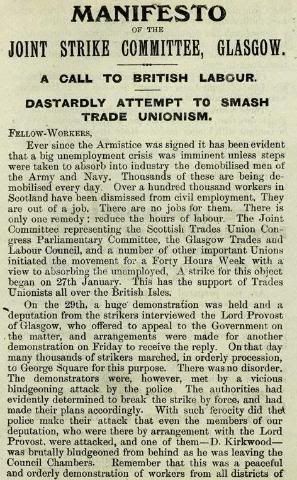
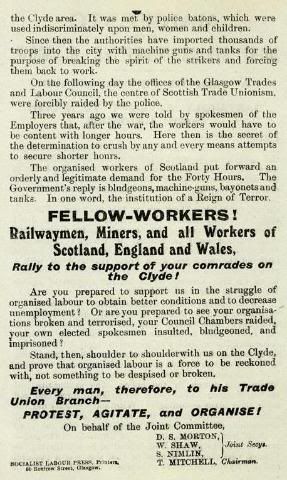
Key members of the CWC and other trade unionists, socialists and Marxists were arrested in the immediate aftermath of 'Bloody Friday'. These included Willie Gallacher, Emmanuel Shinwell and Davie Kirkwood of the CWC. As well as Harry Hopkins, secretary of the ASE and George Edbury, national organiser of the BSP.
Following his arrest, along with Gallacher, Kirkwood and others as one of the leaders of the 40 hours strike, Emmanuel Shinwell was charged with incitement to riot. At the High Court in Edinburgh in 1919 both Shinwell and Gallacher were found guilty and sentenced to 5 months imprisonment.
This letter was written by Shinwell's lawyers advising those witnesses who were to be called in defence of Shinwell at his trial that they should make themselves available to the prosecution lawyers for questioning:
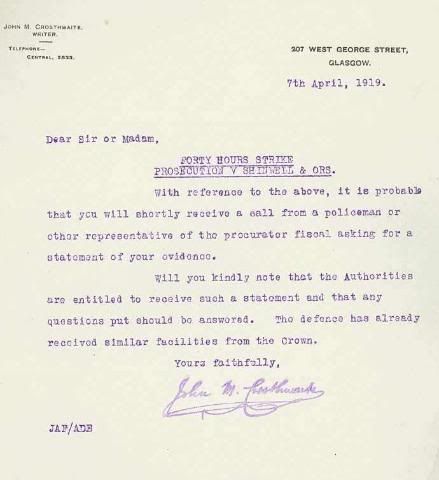
The scene in the High Court in Edinburgh at the trial of the leaders of the 40-hour strike, which led to rioting in Glasgow and the red flag being raised in George Square:

This plan of George Square was used by the defence lawyers of Emmanuel Shinwell and the others at their trial in April 1919. The plan was used in an attempt to show the jury that the riot which took place was caused by the police and not by the strike leaders accused of inciting the crowd to riot.
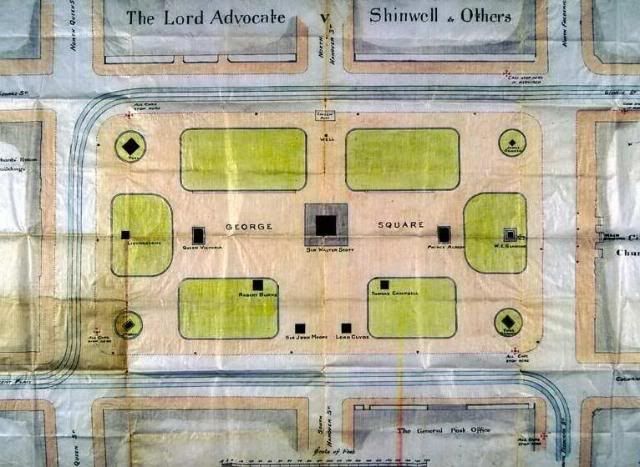
The Clyde Defence Fund was set up to raise monies for the defence of those men arrested in the aftermath of 40 Hours Strike and the 'Battle of George Square'.
Significantly, as shown by the list, a large proportion of the monies collected was donated by labour organisations outwith the Clydeside region.

Within a week of the battle of George Square, the strike was over and a settlement was reached on the basis of a 47-hour working week. This was, of course, a victory for the workers in the short term but did not seriously challenge the role of the bosses.
The ruling class had understood for some time the potential of events on Clydeside. They played a shrewd game of repression on the one hand, as with the jailing of John MacLean, and occasional concessions on the other, as with the Rent Restriction Act. In general, the workers' leaders had a more limited view of what was happening and failed to capitalize on the strength and successes of the workers.
In writing about the forty-hour week strike and the battle of George Square Willie Gallacher sums it all up - "We had forgotten we were revolutionary leaders of the working class. Revolt was seething everywhere, especially in the army. We had within our hands the possibility of giving actual expression and leadership to it, but it never entered our heads to do so. We were carrying on a strike when we ought to have been making a revolution."
Davie Kirwood was born in Parkhead in the East End of Glasgow in 1873 and worked in Beardmores steel forge, also located in Parkhead, from the age of 14 until his election, aged 49, as Independent Labour Party MP for Dunbartonshire in 1922.
Kirkwood was converted to socialism whilst still an apprentice at Beardmores and became active within the AUE, helping to organise a number of engineering disputes in the Clydeside area before becoming chief shop steward at Beardmores and helping to establish the CWC in 1914. Kirkwood also became involved in Labour politics in Glasgow, joining the ILP around 1909 where he worked closely with John Wheatley, James Maxton and Emmanuel Shinwell.
As one of the leaders of the Clyde Workers Committee (CWC), Kirkwood was involved in organising resistance to the Munitions Act during 1915/16, for which he was arrested under the Defence of the Realm Act and deported to Edinburgh for the duration of the war in 1916. Kirkwood was also arrested during the demonstrations on 'Bloody Friday' and this time charged with incitement to riot. However, based on photographic evidence taken by a London-based paper, which showed Kirkwood lying prostrate after being struck by a policeman's truncheon, Kirkwood was found not guilty of this charge. His co-accused Emmanuel Shinwell and Willie Gallacher were not so lucky, they received custodial sentences of 5 months and 1 year respectively.
After serving his prison sentence Shinwell concentrated his efforts on forcing political change, as a member of the ILP he won the parliamentary seat of Linlithgow in 1922 and served in the first Labour government of 1924.
Cranhill Arts Project and Scottish Trade Union Review poster advertising an evening of events to commemorate the 70th anniversary of 'Bloody Friday'.
This poster serves to highlight that although the events that marked this period in history have long since passed into the political folklore of Glasgow the sacrifices endured and the achievements gained by those involved in Labour politics of this period are still deemed worthy of celebration by supporters of the modern day Labour Movement.
The poster gives a list of the main speakers at this event including Labour representatives such as STUC General Secretary Campbell Christie and Labour historians and activists such as John McDermott and Freddy Anderson:
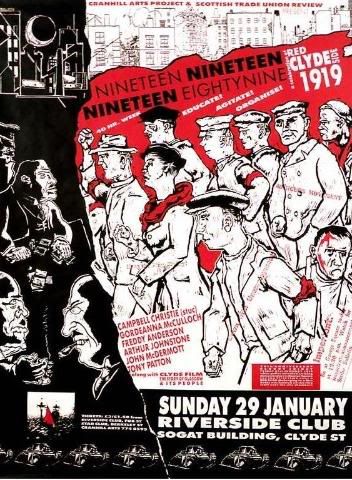
NB.
It has been suggested that the ‘English’ troops that were sent to Glasgow were in fact Scottish troops from regiments stationed outside Glasgow, here is an interesting quote from ‘Roxburgh’:
I have a book at home - with an introduction by Harry McShane - which tells the story of the 40 hours strike in 1919. This book is essentially a reproduction of newspaper articles, photographs and the Strike Bulletin.
One excerpt from The Times of Feb 3rd 1919.
A Veteran Recalls:
I had come home wounded from France and (when my wounds healed) was sent back to the Seaforth Highlanders at Cromarty. We had no idea what was going on in Glasgow. But one morning the whole battallion was paraded and all men from Glasgow and district were told to come out to front of the parade. We thought that was us going to be demobbed but instead we were kept in Cromarty while all the rest (around 700 men) were sent to Glasgow to shoot if it were necessary.
Also ... Minutes of the War Cabinet Meeting, January 30th 1919 .........
Sir William Robertson continuing said that there were certain disadvantages in employing Scottish troops but on the whole he thought it would be safer to use them than to import English battallions.
Evening News - January 31st
The soldiers reached Queen St. Station shortly after ten o'clock ............. the long columns of khaki-clad men who belong to the Seaforths, the Gordons and other Highland regiments.
Interesting. It would be nice if someone could identify the regiments involved from the uniform insignia shown in the photographs.
Most of the above article was taken from various internet sites, whose words I have edited, added to or trimmed.[/quote]









